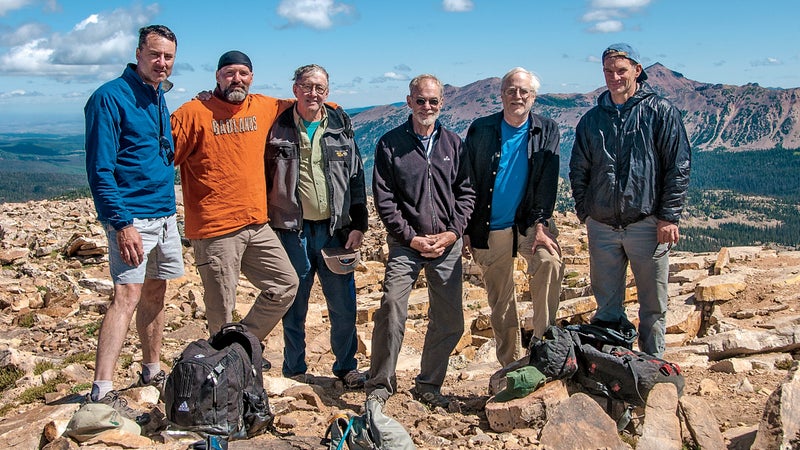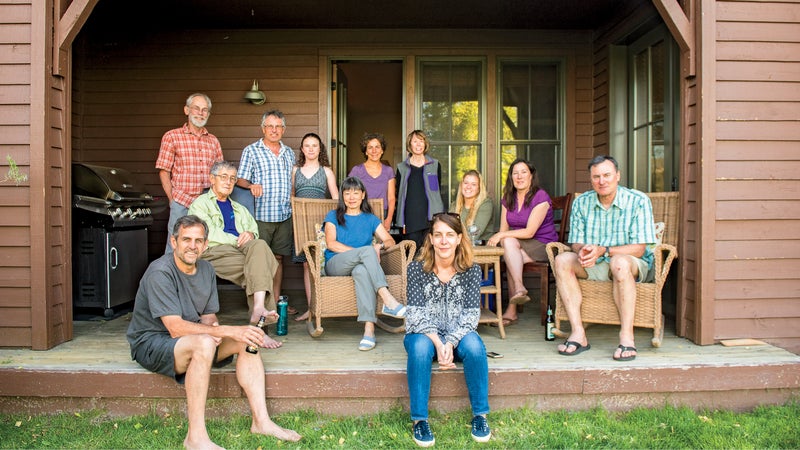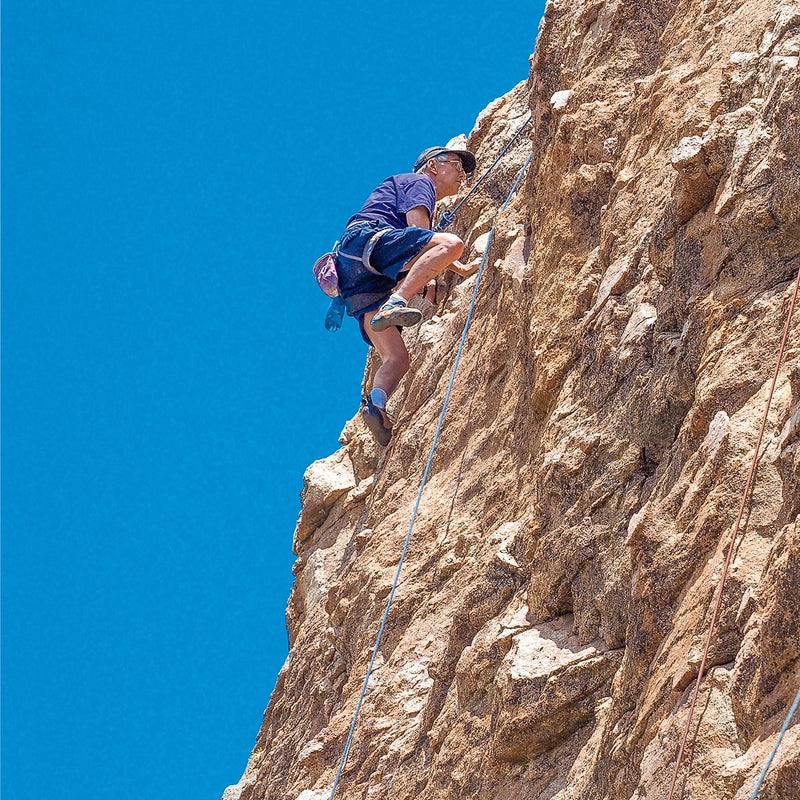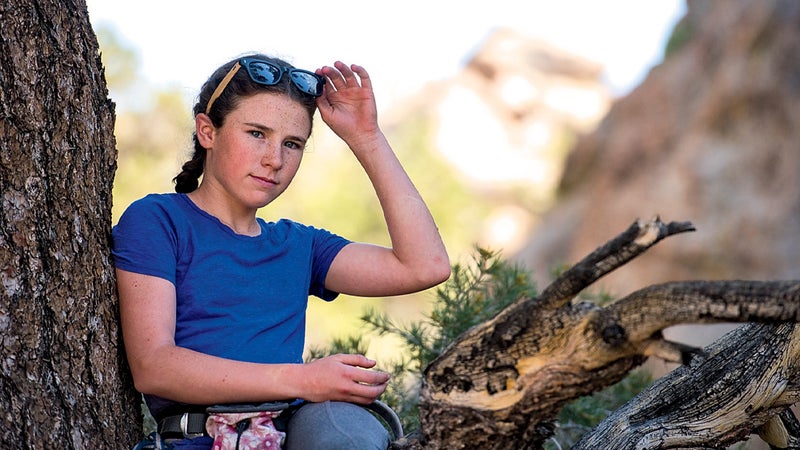The New Old Gang
Change comes for everybody, including a group of adventurous friends who’ve convened for years to climb, swap stories, and hoist a few. These days, their founder is grappling with incurable cancer. On a happier note, their decision to open the doors a little wider has given the gathering a fresh, life-affirming spirit.
New perk: Easily find new routes and hidden gems, upcoming running events, and more near you. Your weekly Local Running Newsletter has everything you need to lace up! .
I tied in and started up the cliff. The route was rated only 5.6, and because one of my friends had led it a few minutes before, I had a top-rope belay. It was the first time in 15 months that I had climbed outdoors—the longest such hiatus of my adult life.
Two years earlier, the 70-foot pitch would have been a trivial warm-up before I tried something “real.” Now it was all the challenge I dared face.
In July 2015, I was diagnosed with Stage IV throat cancer. During the next four months, I got zapped with 35 doses of radiation and seven weeks of chemotherapy. Confined to a hospital for a third of that time, I thought I was about to die on three occasions, and at one low ebb, racked with pain, I was ready to embrace oblivion. By January, back home in Watertown, Massachusetts, I was so weak that when I tried to walk a single block of my street, I had to stop and sit on a neighbor’s wall every 200 feet.
Sometime in early 2016, I called my climbing buddy Ed Ward. We’d been partners on the rope for 45 years, and back in our glory days had paired up on two of the finest first ascents of our lives—Shot Tower in the Brooks Range, and the southeast face of Mount Dickey in the Alaska Range. “I guess no reunion this year,” I said. “Though you could organize one without me.”
“Nah,” he said. “Nobody has the heart for it.”
Back in January of 1996, Ed and I had dreamed up what became a nearly annual reunion, one that grew to involve our best friends in the worlds of climbing and writing. In Las Vegas, on a freelance magazine assignment to cover the AVN Awards—better known as the Oscars of porn—I spent a week interviewing such starlets as Juli Ashton and Jenna Jameson. After a few days I realized that, only 15 miles west of the Flamingo Hotel, the sandstone massif of Red Rock Canyon erupted from the desert—one of the best climbing arenas in the country.
I invited a few of the porn stars to go on a climb, but they politely declined, so I called Ed and demanded that he drop everything, grab a rope and rack, and fly to Vegas. We had so much fun that the next year we invited what we thought of as our old gang on a return trip to the same crags.
In 1997, the gang ranged in age from 41 to 53 and had added other charter members: Matt Hale and Jon Krakauer. My linkage with Matt was even older than with Ed. Back in 1965, when we were in our early twenties, he and I climbed the west face of Alaska’s Mount Huntington, the subject of my first book, . Jon was a student of mine and Ed’s at Hampshire College starting in 1972, and he soon became our equal on rock and ice. (A few years after Jon graduated, I convinced him to quit pounding nails and try to make his living as a writer.) The two junior members of the group, Chris Wejchert and Chris Gulick, both in their forties, had stormed peaks with us over the years, ranging from Katahdin to the Tetons.
Soon we added Aussie-born Greg Child, one of the most talented all-around mountaineers of his generation, whose résumé boasts new routes on El Cap, K2 from the north, and the second ascent of the prize of the Karakoram, Gasherbrum IV. Greg had become a trenchant writer, whose book is the classic account of the 2000 kidnapping and self-rescue in Kyrgyzstan of four young American climbers, including Tommy Caldwell and Beth Rodden.

At Red Rocks, we had such a fund of shared adventures and mishaps that a big part of each day was devoted to dredging up old tales and improving them with each telling. But the trips also generated great new stories. In 1997, for instance, we were hiking in to one of the walls. A team of younger climbers were hot on our heels.
Were they trying to beat us to the first pitch of Epinephrine? No. When their leader caught up to Matt, he breathlessly asked, “Would that be Jon Krakauer in your group?” had been published only months before.
Matt said yes.
“Wow. Do you think I could ask him for an autograph?”
Matt frowned. “I don’t know. He’s a little touchy about that sort of thing.”
“No, no! It’s all right,” the guy said. “It’s enough just to have seen him.”
Throughout the rest of our trip, sitting in our favorite Vegas bar, we would clink beer glasses, gaze at Krakauer, and say, “It’s enough just to have seen him.”
Though we missed a year or two, by 2015 we had rendezvoused on 15 different trips, extending our range from Red Rocks to Skaha in British Columbia and Estes Park in Colorado, as well as the Dolomites of Italy and the Calanques in France. Sometimes we camped, sometimes we rented hotels or condos. Gradually, we added a few more members. Meanwhile, there was an ongoing debate that actually threatened to become contentious.
Some of us, including me, believed our outings should remain all-male; others thought such a stricture was juvenile. The half-spoken worry was that the presence of nonclimbing wives and girlfriends would sabotage our precious brotherhood. Complicating things, back at our home crags, several of us had found female climbing partners who were accomplished enough to join us on these trips.
Doctors had certified that the cancer was gone from my throat and neck. Now I learned that it had metastasized to my lungs. Once cancer metastasizes, it’s incurable.
Fueled by beer and wine, the debate came to a head in 2009, around a bonfire at 10,000 feet in the Uintas of northern Utah. At one point, Chris Reveley, a veteran of Longs Peak and the Diamond, decided to settle it. “The answer is,” he proclaimed, pausing for effect, “women yes, spouses no!” Our laughter confirmed a unanimous vote.
The first recruit was Anne-Laure Treny, an engineer from France whom Ed had befriended at his local gym. Anne-Laure’s balletic grace on rock put us to shame, and she brought a teasing wit that helped civilize us. By 2013, our team contained almost as many women as men, but we still set the bar against wives. We weren’t able to imagine yet that, eventually, our reunions might not only tolerate but benefit from the addition of spouses and kids. If we had, the more reactionary of us might have choked on our sexism.
Forty feet up the 5.6, I was panting to catch my breath, and my mouth was so dry I couldn’t swallow. I had clipped a water bottle to my harness; now I managed to balance on small footholds, retrieve the thing, and take three or four gulps. The only climbing I had done in more than a year was in a gym two miles from my house, and the longest route I’d managed to do topped out at 45 feet.
The crag, called Area 13, lay in a dry canyon near the California-Nevada state line. Around me, my friends were cavorting on 5.9 and 5.10 routes, but I thought that if I could reach an anchor 30 feet above, the 5.6 pitch I’d completed would amount to a minor triumph. In fact, it seemed as important to me as any climb I’d ever done.
Little more than a year before, in May of 2016, I had decided that some of my strength and stamina was at last returning. On a trip to Utah, I hiked as many as four miles at a stretch. But in June, driving home from a short visit to Montreal, I collapsed and had to be hauled to an emergency room in Hanover, New Hampshire. Only a month before, the doctors at Boston’s Dana-Farber Cancer Institute had certified that the cancer was gone from my throat and neck. Now I learned that it had metastasized to my lungs. Once cancer metastasizes, it’s incurable. My best hope was to keep it in check with doses of a radical new form of immunotherapy.
The wasted summer of 2016 passed in a blur of hospital crises and exhausted furloughs. But by January of 2017, I had stayed out of the sick ward for five months. I called Ed. “What the hell,” I said. “Let’s get the gang together for another reunion. Even if I can’t climb, it’d be great just to hang out with you guys.”

On June 17, we gathered in Mammoth Lakes, California, where four years earlier we’d spent a week assaulting five different local crags. One of Mammoth’s draws was the Snowcreek Resort condominiums, where we had basked in swanky lodging right next to a golf course. By this time, we had dropped the no-wives thing. Among the 18 people in our group, ten were women, including three wives, a teenager, and a sixth-grader. We ranged in age from 12 to my graybeard 74, and five of the original six—all but Krakauer—showed up. One of the wives was mine: Sharon Roberts, who in recent years had started climbing at the Watertown gym after a break of decades since our vagabond twenties. On Area 13, I’d reached the anchor and lowered off. She proceeded to solve the route. If I was proud of my first outdoor pitch in 15 months, she was equally thrilled by her first climb on real rock in 35 years.
To my delight, we climbed every day. At Benton Crossing, a granite massif out on the plains, I started a 115-foot route (5.6 again) that I knew would challenge my endurance. Halfway up, a sudden wave of nausea engulfed me. All at once I was vomiting my meager breakfast, spattering the small ledge around my feet. A hush fell. Sharon urged me to come down, but I took a swig of my water and headed shakily on up. I heard Greg Child say, “To one-up Roberts now, I’m gonna have to take a crap on the route.”

The best climb of our eight-day trip happened on June 20, when Sarah Keyes and Emmett Lyman—the most ambitious partners in our group, both in their late thirties—teamed with Greg and his 12-year-old daughter, Ari, to attempt a stern 550-foot, four-pitch 5.10 called Cardinal Pinnacle. During the past year and a half, Ari had blossomed under Greg’s tutelage, taking the lead on well-bolted sport routes. But she had never tried a semi-alpine challenge like this one, which requires a descent of three long rappels.
The grown-ups swapped leads. Ari calmly followed. On the crux traverse, Greg belayed her, out of sight around the corner, as she moved slowly but steadily. Pulling in the rope, Greg nervously pondered the fiasco that might ensue if she “came off” and hung dangling over the void. A small hand appeared. Ari pivoted around the corner and clipped in to Greg’s anchor.
“Was that scary?” he asked.
“A bit,” she admitted.
Ari became the élan vital of our gathering. She brought along a 26-inch aluminum bat and a hard yellow softball, as well as a slightly underinflated football. Late one afternoon, after the golfers had gone home, she lured us onto the grass near the eighth tee to throw and catch and bat. I lobbed slow pitches that she sent screaming past my head. Finding a lost golf ball in the rough, I surprised her by pitching it, too. On her third swing, she clobbered it into the fescue fringing the seventh green. She filled the lulls in our games by turning cartwheels on the grass.
During the first eight months of my cancer treatment in 2015 and 2016, I spent only one night anywhere other than home or a hospital. Just a decade before, as a magazine writer and author, I had traveled up to 200 days a year, often to other continents. My new confinement seemed to strangle my spirit, and depression often sat at my elbow.
Beginning in March of 2016, with a cautious four-day trip to North Carolina, I fled Watertown five times. The longest such trip was a two-week ramble in the Anasazi canyons of southeast Utah. Each trip felt like a risky bargain, a dare flung out against the mindless cancer cells that were roaming through my body.
We’d usually been lucky—no big medical dramas—and it seemed like we were getting away with it again at Mammoth Lakes. But on the next to last morning, I woke at 4 A.M. shivering uncontrollably, my hands and feet spasming, trying desperately to catch my breath as I heard a gurgling rattle in my lungs. Sharon’s face looked stricken as she whispered, “We have to call 911.”
“No!” I pleaded. I had my heart set on the day’s plan for another new crag. Then I threw up, the vomit laced with blood.
EMTs carried me to an ambulance; an oxygen mask was clapped over my nose and mouth. In the ER, doctors and nurses hooked me up to IV fluids and monitors. Within hours, I was moved to the ICU, then to the Mammoth hospital. The doctors diagnosed “community acquired” bacterial pneumonia. Immobilized in a sterile, windowless room, I wept as Sharon held my hand.
If Ari had turned her back on climbing and flung herself into skateboarding or piano instead, that would have been fine with him. The spark was hers.
“Tell the others to go ahead and climb,” I begged her, but instead they showed up in twos and threes, masks strapped on their faces. Their solemn looks seemed to mirror my own dismay, but there was no mistaking how much they had invested in my recovery. Ed later told me, “Everybody sort of needed a rest day anyway.” Sarah Keyes said, “There were many conversations at the house in which folks were brainstorming how they and we could all work together to take care of you both.”
Metastasized cancer is not an automatic death sentence. No doctor has told me I should expect to live for only x months or years, and immunotherapy is in such infancy that almost anything could happen. But one thing seems clear: I will never regain more than a fraction of the strength or stamina I used to take for granted.
In Mammoth, I was released after 30 hours. Back at the condo, my friends greeted me like a prodigal son, but the joy of our last evening was subdued. I wondered how many of them were thinking: Is this the last time we’ll meet together to climb?
When we first launched our rendezvous in the 1990s, the male camaraderie disguised an urge to hang on to the intensity of our younger years. All six of our original group, as well as Greg, had started climbing in their late teens or soon after. By our early twenties, all of us would have said that climbing was the most important thing in life—a pursuit so glorious that it was worth the risk of death. On the expeditions we organized to the great ranges, the game was always played for keeps. We despaired of ever landing meaningful jobs, happy to embrace the bohemian squalor of the dirtbag life.
Our friends who rounded out the Mammoth crew, except for the two teenagers—Ari and Emma, Anne-Laure’s 18-year-old daughter—had come to climbing later in life, with well-established careers. None of them, not even Sarah and Emmett, would have sworn that climbing was worth all the rest of life put together.
By 2017, the diehard core of seven had moved in the same direction, at last accepting our diminished powers. We could admit, with Tennyson’s Ulysses, that “We are not now that strength which in old days / Moved earth and heaven.” By dropping our silly rules about membership, we had opened our hearts to the subtler glory of fine times on the crags, shared across generations. In passing on to his daughter a sliver of the vision he had won on K2 and Gasherbrum IV, Greg had affirmed that continuum. But if Ari had turned her back on climbing and flung herself into skateboarding or piano instead, that would have been fine with him. The spark was hers.

I never wanted to have children myself. But in Ari, especially after cancer struck me down, I rediscovered hope. At the age of one month, in 2004, she shared her first campout with me, as Greg and I crossed a highway during an 18-day traverse of the Comb Ridge in Arizona and Utah. At eight, along with Greg and Sharon and me, she backpacked for three days into a remote canyon where, decades earlier, I had discovered a pristine 1,500-year-old Anasazi basket tucked inside an obscure alcove by its owner.
It was I who’d taught Ari how to throw a football and hit a softball, Greg not being particularly adept at those mainstream American games. During the Mammoth Lakes trip, in the forest below a climbing area called Horseshoe Slabs, she stripped the twigs off a fallen branch to craft a backwoods bat. As I pitched pine cones to her, she yelped with delight every time she connected. And at Area 13, I stood in awe beneath the cliff as she deftly led pitches on which I knew I could barely get off the ground.
Often I think about Ari, gliding like a sylph toward her limitless future. I picture her at 25, having fulfilled some of her dreams—dreams I like to think I had a part in shaping. By then, alas, in all likelihood I won’t be around to share her joy. But I shared it in Mammoth Lakes, with all our old-new gang, for whom each night the dwindling of our energies only presaged a new adventure on the coming day.
David Roberts has written for ���ϳԹ��� since 1980. His books include , , and . Camilla Perkins is an ���ܳٲ��������contributing artist.


